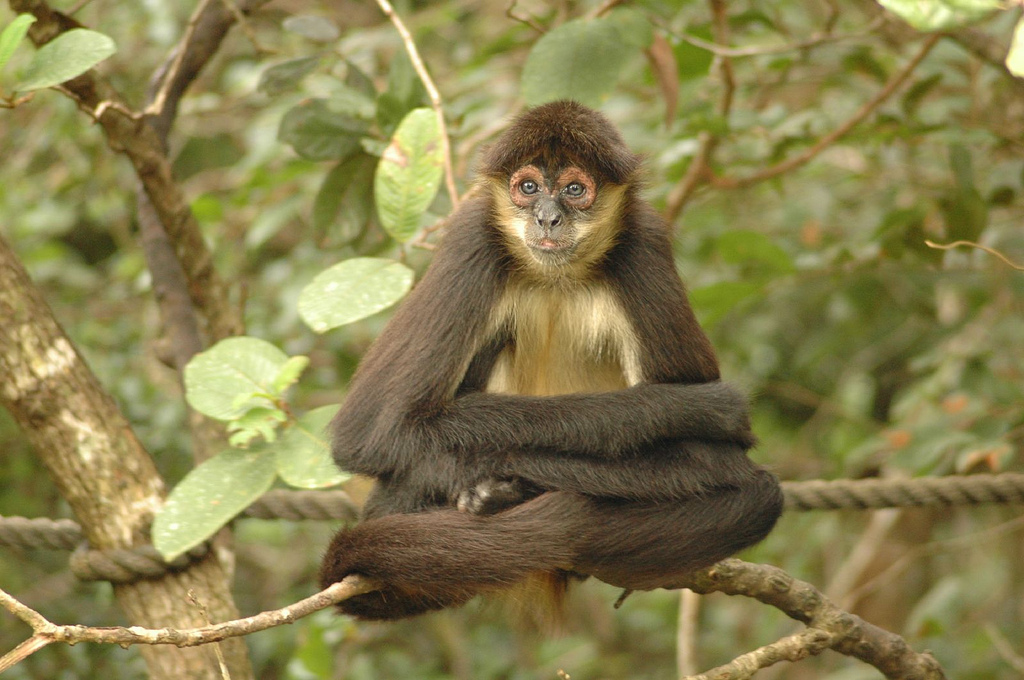|
Korubo People
The Korubo or Korubu, also known as the , are a largely uncontacted, Panoan-speaking indigenous people of Brazil living in the lower Vale do Javari in the western Amazon Basin. The group calls themselves , and in Portuguese they are referred to as ''caceteiros'' (clubbers). Much of what the outside world knows of this group is based on the research of Brazilian explorer Sydney Possuelo, who first contacted the tribe in October 1996, and journalist Paul Raffaele. Region The Flecheiros live in the far west of Brazil, in the Vale do Javari Indigenous Territory, an area covering . Access to the Vale do Javari Indigenous Territory is limited by the government of Brazil to protect the indigenous groups inhabiting the area and the environment on which they depend for their traditional lifeways from exploitation by loggers, miners, poachers, drug traffickers and others. Several other indigenous peoples live in this territory, including the Kanamari and the Tsohom Djapa, who sp ... [...More Info...] [...Related Items...] OR: [Wikipedia] [Google] [Baidu] |
Uncontacted Peoples
Uncontacted peoples are groups of Indigenous peoples living without sustained contact with neighbouring communities and the world community. Groups who decide to remain uncontacted are referred to as indigenous peoples in voluntary isolation. Legal protections make estimating the total number of uncontacted peoples challenging, but estimates from the Inter-American Commission on Human Rights in the United Nations, UN and the nonprofit group Survival International point to between 100 and 200 uncontacted tribes numbering up to 10,000 individuals total.Report of the Regional Seminar on Indigenous peoples in voluntary isolation and in initial contact of the Amazonian Basin and El Chaco, Santa Cruz de la Sierra, Bolivia (20–22 November 2006), presented by the Office of the United Nations High Commissioner for Human Rights (OHCHR) and the International Work Group on Indigenous Affairs (IWGIA), E/C.19/2007/CRP.1, March 28, 2007, paragraph 1. A majority of uncontacted peoples live in So ... [...More Info...] [...Related Items...] OR: [Wikipedia] [Google] [Baidu] |
National Geographic Magazine
''National Geographic'' (formerly ''The National Geographic Magazine'', sometimes branded as ''Nat Geo'') is an American monthly magazine published by National Geographic Partners. The magazine was founded in 1888 as a scholarly journal, nine months after the establishment of the society, but is now a popular magazine. In 1905, it began including pictures, a style for which it became well known. Its first color photos appeared in the 1910s. During the Cold War, the magazine committed itself to present a balanced view of the physical and human geography of countries beyond the Iron Curtain. Later, the magazine became outspoken on environmental issues. Until 2015, the magazine was completely owned and managed by the National Geographic Society. Since 2015, controlling interest has been held by National Geographic Partners. Topics of features generally concern geography, history, nature, science, and world culture. The magazine is well known for its distinctive appearance: a ... [...More Info...] [...Related Items...] OR: [Wikipedia] [Google] [Baidu] |
Malaria
Malaria is a Mosquito-borne disease, mosquito-borne infectious disease that affects vertebrates and ''Anopheles'' mosquitoes. Human malaria causes Signs and symptoms, symptoms that typically include fever, Fatigue (medical), fatigue, vomiting, and headaches. In severe cases, it can cause jaundice, Epileptic seizure, seizures, coma, or death. Symptoms usually begin 10 to 15 days after being bitten by an infected ''Anopheles'' mosquito. If not properly treated, people may have recurrences of the disease months later. In those who have recently survived an infection, reinfection usually causes milder symptoms. This partial Immunity (medical), resistance disappears over months to years if the person has no continuing exposure to malaria. The mosquitoes themselves are harmed by malaria, causing reduced lifespans in those infected by it. Malaria is caused by protozoa, single-celled microorganisms of the genus ''Plasmodium''. It is spread exclusively through bites of infected female ... [...More Info...] [...Related Items...] OR: [Wikipedia] [Google] [Baidu] |
Manioc
''Manihot esculenta'', common name, commonly called cassava, manioc, or yuca (among numerous regional names), is a woody shrub of the spurge family, Euphorbiaceae, native to South America, from Brazil, Paraguay and parts of the Andes. Although a perennial plant, cassava is extensively cultivated in tropical and subtropical regions as an annual crop for its edible starchy tuberous root. Cassava is predominantly consumed in boiled form, but substantial quantities are processed to extract cassava starch, called tapioca, which is used for food, animal feed, and industrial purposes. The Brazilian , and the related ''garri'' of West Africa, is an edible coarse flour obtained by grating cassava roots, pressing moisture off the obtained grated pulp, and finally drying it (and roasting in the case of both and ''garri''). Cassava is the third-largest source of carbohydrates in food in the tropics, after rice and maize, making it an important staple food, staple; more than 500 million pe ... [...More Info...] [...Related Items...] OR: [Wikipedia] [Google] [Baidu] |
Suina
Suina (also known as Suiformes) is a suborder of omnivorous, non- ruminant artiodactyl mammals that includes the domestic pig and peccaries. A member of this clade is known as a suine. Suina includes the family Suidae, termed suids, known in English as pigs or swine, as well as the family Tayassuidae, termed tayassuids or peccaries. Suines are largely native to Africa, South America, and Southeast Asia, with the exception of the wild boar, which is additionally native to Europe and Asia and introduced to North America and Australasia, including widespread use in farming of the domestic pig subspecies. Suines range in size from the 55 cm (22 in) long pygmy hog to the 210 cm (83 in) long giant forest hog, and are primarily found in forest, shrubland, and grassland biomes, though some can be found in deserts, wetlands, or coastal regions. Most species do not have population estimates, though approximately two billion domestic pigs are used in farming, ... [...More Info...] [...Related Items...] OR: [Wikipedia] [Google] [Baidu] |
Birds
Birds are a group of warm-blooded vertebrates constituting the class (biology), class Aves (), characterised by feathers, toothless beaked jaws, the Oviparity, laying of Eggshell, hard-shelled eggs, a high Metabolism, metabolic rate, a four-chambered heart, and a strong yet lightweight Bird skeleton, skeleton. Birds live worldwide and range in size from the bee hummingbird to the common ostrich. There are over 11,000 living species and they are split into 44 Order (biology), orders. More than half are passerine or "perching" birds. Birds have Bird wing, wings whose development varies according to species; the only known groups without wings are the extinct moa and elephant birds. Wings, which are modified forelimbs, gave birds the ability to fly, although further evolution has led to the Flightless bird, loss of flight in some birds, including ratites, penguins, and diverse endemism, endemic island species. The digestive and respiratory systems of birds are also uniquely a ... [...More Info...] [...Related Items...] OR: [Wikipedia] [Google] [Baidu] |
Peccary
Peccaries (also javelinas or skunk pigs) are pig-like ungulates of the family Tayassuidae (New World pigs). They are found throughout Central and South America, Trinidad in the Caribbean, and in the southwestern area of North America. Peccaries usually measure between in length, and a full-grown adult usually weighs about . They represent the closest relatives of the family Suidae, which contains pigs and relatives. Together Tayassuidae and Suidae are grouped in the suborder Suina within the order Artiodactyla ( even-toed ungulates). Peccaries are social creatures that live in herds. They are omnivores and eat roots, grubs, and a variety of other foods. They can identify each other by their strong odors. A group of peccaries that travel and live together is called a squadron. A squadron of peccaries averages between six and nine members. Peccaries first appeared in North America during the Miocene and migrated into South America during the Pliocene–Pleistocene as part of ... [...More Info...] [...Related Items...] OR: [Wikipedia] [Google] [Baidu] |
Spider Monkey
Spider monkeys are New World monkeys belonging to the genus ''Ateles'', part of the subfamily Atelinae, family Atelidae. Like other atelines, they are found in tropical forests of Central and South America, from southern Mexico to Brazil. The genus consists of seven species, all of which are under threat; the brown spider monkey is critically endangered. They are also notable for their ability to be easily Monkey breeding, bred in captivity. Disproportionately long limbs and long prehensile tails make them one of the largest New World monkeys and give rise to their common name. Spider monkeys live in the upper layers of the rainforest and forage in the high canopy, from . They primarily eat fruits, but will also occasionally consume leaves, flowers, and insects. Due to their large size, spider monkeys require large tracts of moist evergreen forests, and prefer undisturbed primary rainforest. They are social animals and live in bands of up to 35 individuals, but will split up to ... [...More Info...] [...Related Items...] OR: [Wikipedia] [Google] [Baidu] |
Roucou
Annatto ( or ) is an orange-red condiment and food coloring derived from the seeds of the achiote tree (''Bixa orellana''), native to tropical parts of the Americas. It is often used to impart a yellow to red-orange color to foods, but sometimes also for its flavor and aroma. Its scent is described as "slightly peppery with a hint of nutmeg" and its flavor as "slightly nutty, sweet, and peppery". The color of annatto comes from various carotenoid pigments, mainly bixin and norbixin, found in the reddish waxy coating of the seeds. The condiment is typically prepared by grinding the seeds to a powder or paste. Similar effects can be obtained by extracting some of the color and flavor principles from the seeds with hot water, oil, or lard, which are then added to the food. Annatto and its extracts are now widely used in an artisanal or industrial scale as a coloring agent in many processed food products, such as cheeses, dairy spreads, butter and margarine, custards, cakes and oth ... [...More Info...] [...Related Items...] OR: [Wikipedia] [Google] [Baidu] |
Malocas
A maloca is an ancestral Longhouse, long house built by Indigenous people of the Amazon Basin, Amazon, notably in Colombia and Brazil. Each community has a single maloca with its distinct characteristics. Several families with Patrilineality, patrilineal or matrilineal relations live together in a maloca, distributed around the long house in different compartments. In general, the Tribal chief, chief of the local descent group lives in the compartment nearest to the back wall of the long house. As well, each family has its own hearth. During festivals and in formal ceremonies, which involve dances for males, the long house space is rearranged; the centre of the long house is the most important area where the dance takes place. Each maloca has two entrances, one for men and one for women. Married men and women sleep together, and unmarried men and women sleep separately. A maloca is traditionally surrounded by two gardens: the inner called the kitchen gardens (growing plants s ... [...More Info...] [...Related Items...] OR: [Wikipedia] [Google] [Baidu] |
FUNAI
is a Japanese consumer electronics company headquartered in Daitō, Osaka. Currently, it is in liquidation. Apart from producing its own branded electronic products, it was also an OEM providing assembled televisions and video players/recorders to major corporations such as Sharp, Toshiba, Denon, and others. Funai supplies inkjet printer hardware technology to Dell and Lexmark, and produces printers under the Kodak name. Its United States–based subsidiary Funai Corporation, Inc., based in Torrance, California, markets Funai products in the US, along with Funai-licensed brands including Philips, Magnavox, Emerson Radio, and Sanyo. Funai is the main supplier of electronics to Walmart and Sam's Club stores in the US, with production output in excess of 2 million flat-panel televisions during the summertime per year for Black Friday sale. History Funai was founded by Tetsuro Funai, the son of a sewing machine manufacturer. During the 1950s before the company was form ... [...More Info...] [...Related Items...] OR: [Wikipedia] [Google] [Baidu] |








